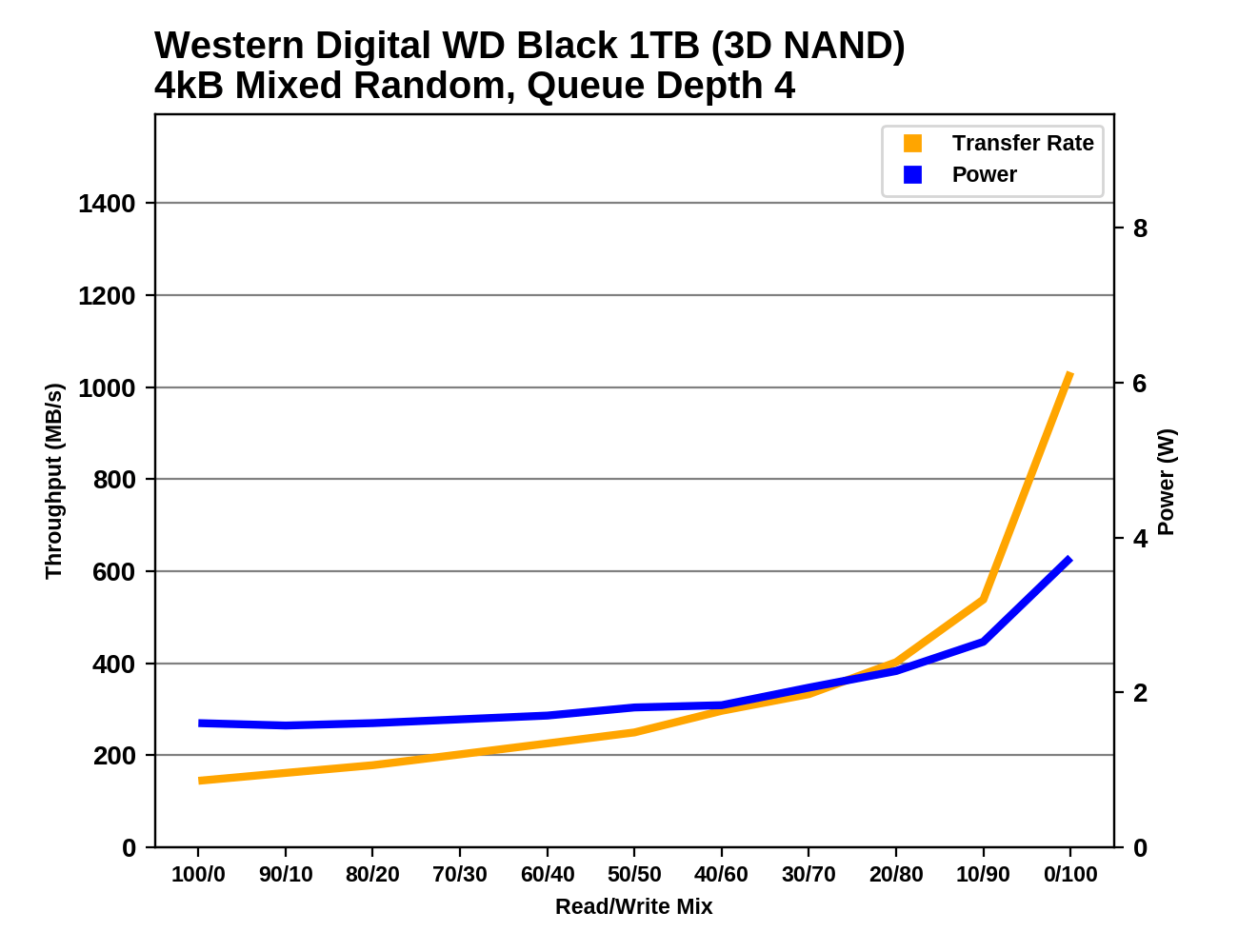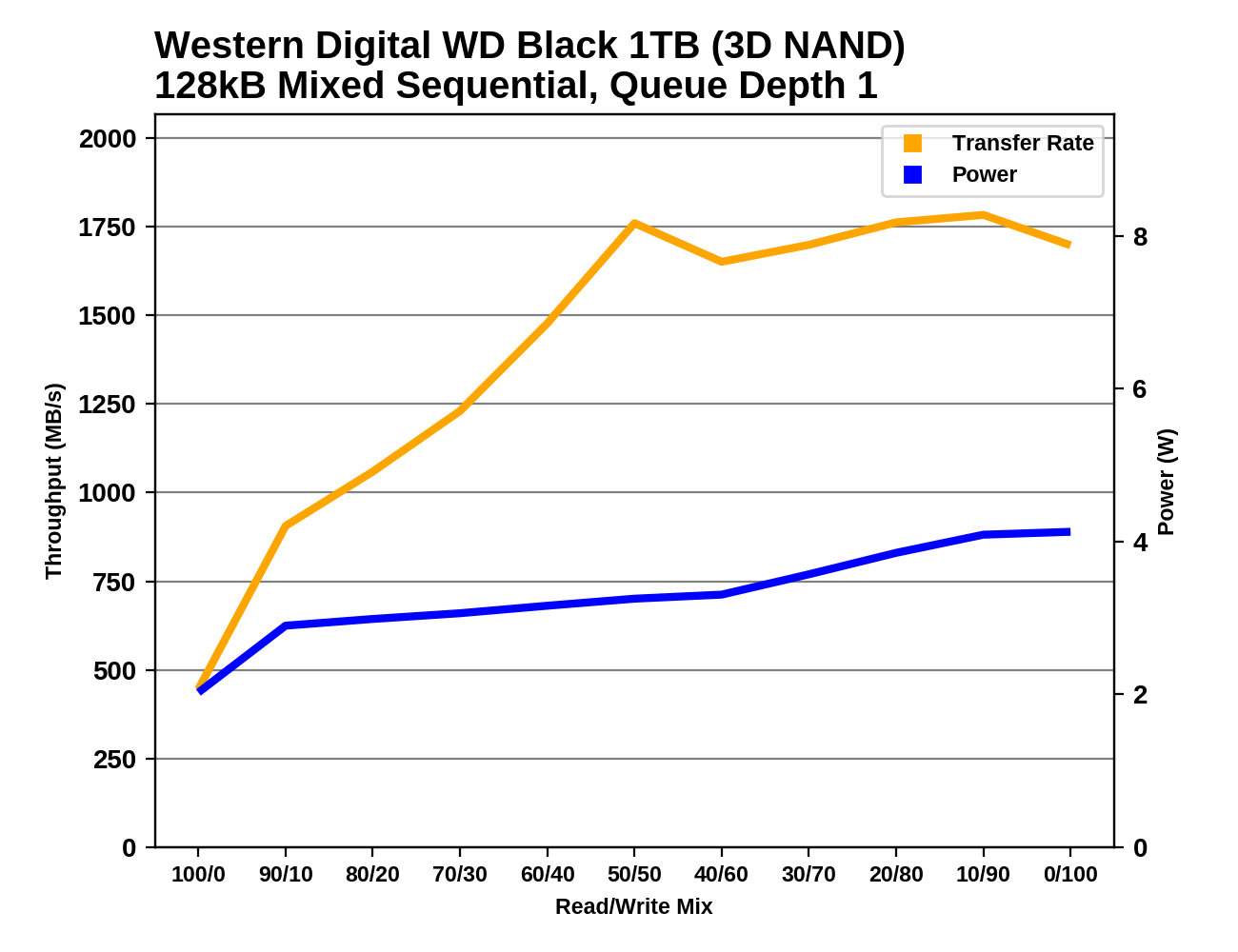The Western Digital WD Black 3D NAND SSD Review: EVO Meets Its Match
by Ganesh T S & Billy Tallis on April 5, 2018 9:45 AM EST- Posted in
- SSDs
- Storage
- Western Digital
- SanDisk
- NVMe
- Extreme Pro
- WD Black
Mixed Random Performance
Our test of mixed random reads and writes covers mixes varying from pure reads to pure writes at 10% increments. Each mix is tested for up to 1 minute or 32GB of data transferred. The test is conducted with a queue depth of 4, and is limited to a 64GB span of the drive. In between each mix, the drive is given idle time of up to one minute so that the overall duty cycle is 50%.

The WD Black offers great mixed random I/O performance, but it is still slightly slower overall than the best drives from Samsung, and the Optane SSD is in an entirely different league.
 |
|||||||||
| Power Efficiency in MB/s/W | Average Power in W | ||||||||
The WD Black's power efficiency on the mixed random I/O test is about the same as that of the Samsung 960 PRO, and close to the Optane SSD in spite of the vast difference in absolute performance level.
 |
|||||||||
The performance of the WD Black grows very slowly as the workload shifts from reads toward writes, but near the end of the test the good SLC write caching implementation gives the WD Black steep gains. Power consumption is under 2W for most of the test and doesn't quite reach 4W at the very end.
Mixed Sequential Performance
Our test of mixed sequential reads and writes differs from the mixed random I/O test by performing 128kB sequential accesses rather than 4kB accesses at random locations, and the sequential test is conducted at queue depth 1. The range of mixes tested is the same, and the timing and limits on data transfers are also the same as above.

The mixed sequential workload performance of the WD Black is surprisingly good, just barely behind the Optane SSD and far ahead of almost all flash-based SSDs.
 |
|||||||||
| Power Efficiency in MB/s/W | Average Power in W | ||||||||
The WD Black draws about the same power as other SSDs during the mixed sequential test, and combined with the great performance that translates to a huge lead in power efficiency.
 |
|||||||||
The performance scaling pattern of the WD Black on the mixed sequential test is quite unusual. Many drives show a bathtub curve with peak performance at either end of the test when the workload is pure reads or pure writes, and the worst performance in the middle of the test. By contrast, the WD Black starts out rather slowly but rapidly speeds up during the first half of the test, and stays near full performance for the entire second half.










69 Comments
View All Comments
Mr Perfect - Friday, April 6, 2018 - link
On one hand I appreciate having a mechanical in the charts to see how these SSDs compare, since it's a great way to show the benefits of upgrading to one. On the other hand it makes the SSD results really hard to read, as they become disappearingly small. Hopefully one day we won't have to show people the difference.Billy Tallis - Friday, April 6, 2018 - link
It's not something I plan to include in most reviews. I only added it for this one because the mechanical drive I happened to have on hand to benchmark was also a 1TB WD Black. On a lot of reviews, I leave out Optane drives for the same reasons.amar.znzi - Friday, April 6, 2018 - link
> The new controller has a tri-core architecture (probably using Arm Cortex-R cores) fabricated in a 28nm process.Please don't speculate. Can you confirm with WD which Instruction Set Architecture is being used?
Billy Tallis - Sunday, April 8, 2018 - link
We asked repeatedly, and all we could get was that it isn't RISC-V. But every other NVMe controller used in consumer SSDs uses Cortex-R, and there's no reason to suspect WD is doing anything different. There aren't many alternatives. They designed this controller architecture to put as much of the important functionality on dedicated hardware as possible, so doing something unusual with the CPU cores doesn't present much opportunity for improving performance or efficiency.Klimax - Sunday, April 8, 2018 - link
Maybe ARC. (Intel uses it for some of their MEs)amar.znzi - Saturday, April 14, 2018 - link
Oh, it's not. WD has anounced that it intends to transition a large volume of it's products to RISC-V. Thanks, that answered my question.HStewart - Sunday, April 8, 2018 - link
One question, I have is there any real advantage of using this model version cheaper model - in an USB-C Gen 2 case?SanX - Sunday, April 8, 2018 - link
Which tasks will benefit from fast drives and which will not in real life ? Will Antivirus full clean go faster then 3-4 days currently? Or archieving? Or search for file with specific content? Having 10x read speed will loading Windows go 10x faster then with neanderthal mechanical Western Digital Gold hard drives or only by mere 10%? That what I like to see as tests not that semi-nonsence which resembles proverbial fake news of political media.Good would be to see the temperature map on a heavy load, the 10, 13 and even on some drives 20 Watts for such small formfactor is a lot.
Also I still keep for history some old hard drives which don't giveup their life after 30 years. Will these new ones with guaranteed 5 years then disintegrate after 10?
MajGenRelativity - Tuesday, April 10, 2018 - link
Most people don't keep their hard drives for 30 years, as the interface connector is far obsolete by now. I'm not even certain that IDE/PATA goes back that far, and you'd most likely need a highly specialized product to even read/write to that drive. 10 years for an SSD is a reasonable lifespan, as you'd probably upgrade to something faster or denser after that time.Rami Meir - Thursday, April 12, 2018 - link
I would like to see:1. 2TB 2280 and 4TB 22110
2. IOPS performance @ QD=1
P.S. SW Drivers available at www.nvmexpress.org
Warranty period directly calculated based on the Endurance fures